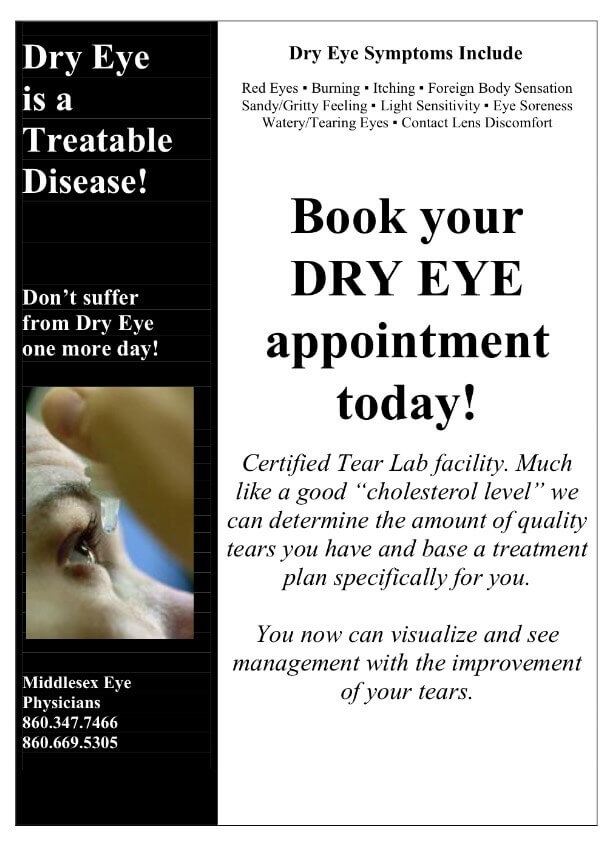Dry Eye Disease
Dry eye is a common condition that is related to the tear system of the eye. It affects millions of people around the world. The symptoms of dry eye can range from mild to severe discomfort. Almost everyone has had symptoms from a temporary reaction to something in the environment. Often, dry eye becomes a chronic condition. Ongoing symptoms of dry eye are not something to ignore. If not treated properly, dry eye can progress and impact your ability to see clearly. There are a variety of causes of dry eye. Finding the most effective treatment depends on proper diagnosis of what is actually causing the problem. The doctors at Middlesex Eye Physicians offer dry eye diagnosis and treatment at our convenient offices in Middletown and Westbrook. Our team will help you understand the underlying causes of your dry eye and will then recommend the right treatment for you.
What Are the Symptoms of Dry Eye?
Common symptoms of dry eye syndrome include the following:
- Stinging or burning sensation
- Scratchy or gritty feeling
- Blurry vision
- Eye redness
- Eye pain
- Discomfort wearing contact lenses
- Stringy mucous buildup around the eyes
- Excessive tearing
How Can Dry Eye Disease Cause Excessive Tearing?
Meibomian Gland Dysfunction (MGD), a leading cause of dry eye disease, can often lead to tearing. There are many layers to the tear film. The Meibomian Glands produce the lipid layer which is responsible for keeping the tear film on the ocular surface and helps prevent evaporation of the tears. When the lipid layer is deficient, the patient experiences tearing because the tear film tends to fall off the ocular surface easier.
What is the Tear Film?
The tear film is essential for good vision. When you blink, a film of tears spreads over the eye, making the surface of the eye smooth and clear. Besides keeping the eyes lubricated, the tear film maintains the integrity of the eye’s surface. Without a healthy tear film, the front surface of the eye is more susceptible to irritation, infection, and allergic reaction. Inflammation of the cornea can lead to blurry vision. In severe cases, corneal scarring can lead to permanent vision impairment.
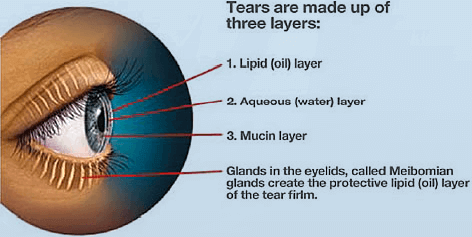
The tear film has three layers that cover and protect the eye:
- The outer oily (lipid) layer is produced by the meibomian glands. It reduces evaporation and prevents the watery layer from draining too quickly.
- The middle (aqueous) layer is produced by the lacrimal glands. The aqueous layer is watery and nourishes the eye with water soluble proteins. It cleans the eye and washes away foreign particles.
- The inner (mucin) layer, produced by the conjunctiva, spreads the watery layer over the entire eye and keeps it moist. It also helps anchor the tear film onto the ocular surface.
What Causes Dry Eye?
There are many things that can cause dry eye. The symptoms are generally caused by a problem with either the quantity or the quality of tears that the eye produces. The most common problem occurs when the eyes do not produce enough tears. Although dry eye affects people of all ages, tear production decreases as a result of aging.
Women seem to be more affected than men, and this may be related to hormonal changes after menopause. In some instances, tear film evaporates too quickly. Sometimes there are enough tears, but the quality of those tears may not keep the eyes properly lubricated. The quality of tears is also related to their chemical balance. Dry eyes can cause the eyes to become inflamed and cause chronic irritation.
Why Don’t My Eyes Produce Enough Tears?
There are many possible reasons that your eyes aren’t producing enough tears. These could include:
- Side effects of medications such as antihistamines, decongestants, beta blockers, diuretics, pain relievers, hormone replacement therapy, antidepressants, and anti-anxiety pills
- Natural changes related to aging and menopause
- Rheumatoid arthritis, Sjogren’s syndrome, lupus, and other autoimmune disorders
- Thyroid disorders
- Not blinking enough when looking at digital devices like a computer, TV, or smartphone
- Side effect of LASIK or other laser eye surgery
What Causes the Tear Film to Evaporate?
- Meibomian Gland Dysfunction (MGD)
- Blepharitis (inflammation of the eyelids; this often leads to MGD)
- Rosacea and eczema (inflammatory skin diseases) which often correlate with Blepharitis
- Exposure to windy, smoky, or dry environments
How Do Doctors Test for Dry Eye?
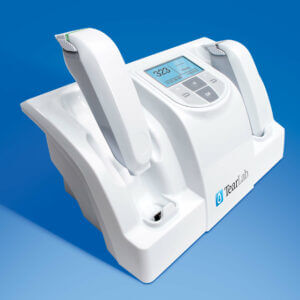
Patients with dry eye symptoms need a comprehensive eye examination and dry eye evaluation by a Middlesex Eye Physicians specialist. Your eye doctor may order some special tests that can measure the volume and quality of tears.
Other tests measure how long it takes the eye to make tears. Some of the more common tests for dry eye syndrome include:
- Discussing your medical history which may reveal lifestyle and environmental triggers for dry eye.
- Epithelial staining involves inserting eye drops containing dye, which shows how long it takes for tears to dry, as well as exposing ocular surface defects caused by dry eye.
- Meibomian Gland evaluation: the doctor will assess the health of the glands through a microscope and evaluate if the glands are working properly.
- Meibography Lipiscan is a technology which uses infrared light to visualize the Meibomian Glands. It is non-invasive and very informative.
- Evaluation with Tear Lab osmolarity diagnosis machine.
Middlesex Eye Physicians is an Accredited Dry Eye Center for the Tear Lab system. This machine can quickly provide osmolarity testing, which measures the ratio of salt to water in tear composition.
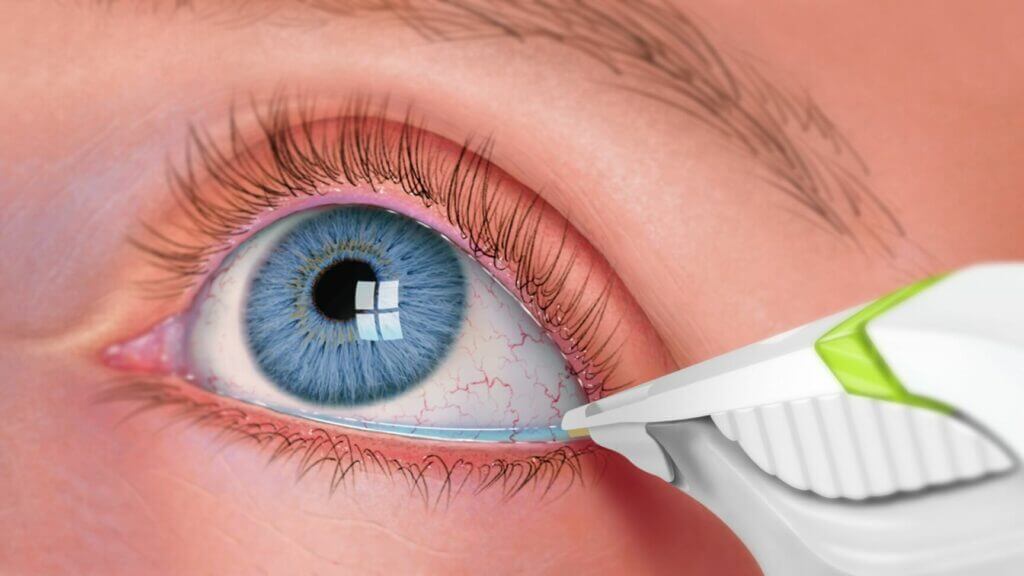
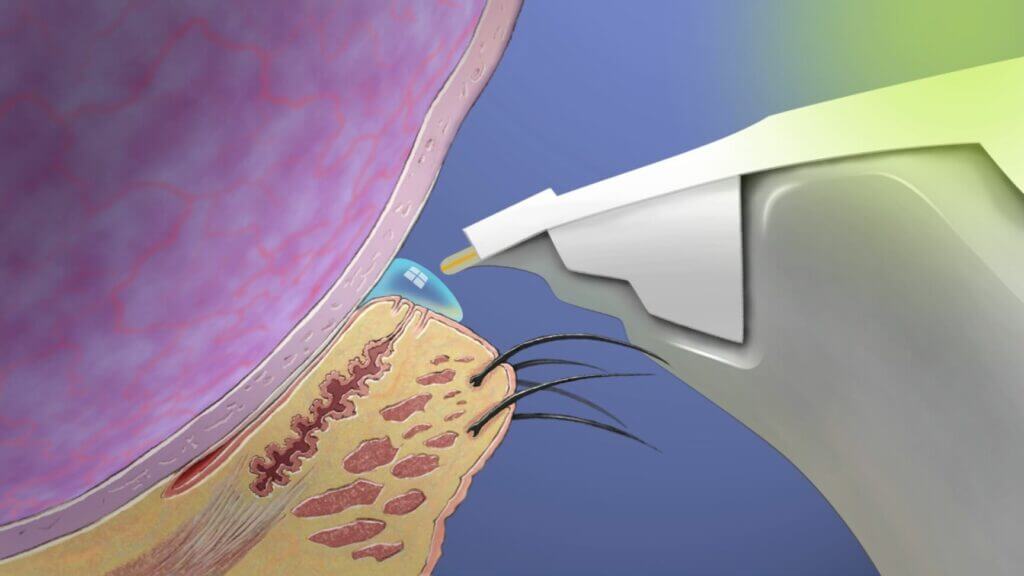
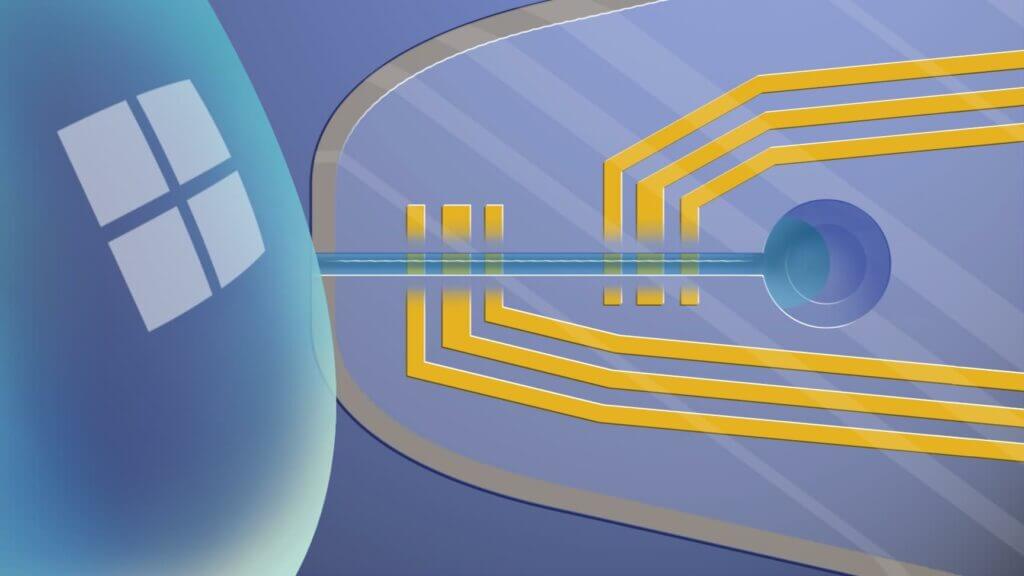
What are the Treatments for Mild Dry Eye Symptoms?
Mild dry eye symptoms can often be relieved with simple lifestyle changes or over-the-counter treatments:
- Take short breaks and blink your eyes frequently when reading and using the computer, smartphone, or TV.
- Apply a hot compress mask, that is microwaveable and reusable, over the eyes frequently. We sell these in our optical shop.
- Use non-prescription artificial tear drops, especially in dry climates. Preservative-free drops are recommended if you’re using artificial tears several times a day or you will have a sensitivity to preservatives over time.
- Apply artificial tear gels or ointments at bedtime, use a sleep mask (many of us sleep with our eyes slightly open).
- Clean your eyes with an eyelid scrub daily to reduce bacteria. (SteriLid spray, Ocusoft, Avenova)
- Ask your doctor about alternative prescription medications that might reduce side effects of dry eye.
- Wear wrap-around sunglasses to protect from wind and sun.
- Stay hydrated by drinking enough fluids.
- Use a humidifier in dry environments.
- Eat foods that are high in Omega-3 fatty acids or find a good quality supplement to take as directed.
- Stop smoking and/or avoid smoky environments.
What Medical Treatments Are Available for Dry Eye?
Dry eye disease is an increasing problem, especially with the amount of screen time people engage in each day. New treatments are always under development. Your eye care specialists at Middlesex Eye are proud to offer new treatment options as they become available.
Prescription Drugs
Your eye doctor may recommend prescription eye drops. These can be used in combination with, or instead of artificial tears.
- Some eye drops contain ingredients which decrease inflammation and help the eye produce more natural tears.
- Steroid eye drops are sometimes recommended while using artificial tears or other eye drops. They can reduce inflammation rapidly.
- Short-term use of steroid eyedrops is generally safe, but complications such as increased eye pressure can develop from extended use of steroid drops.
Punctal Plugs
Your Middlesex Eye doctor may recommend punctal plugs. Punctal plugs are tiny devices that your eye doctor can insert into tear drainage ducts. This helps moisturize your eyes by preventing the tear layer from draining too quickly. Punctal plugscan be inserted in a simple and safe office procedure.
Tired of living with the frustrating symptoms of dry eye syndrome? Get the help you need by scheduling an appointment at Middlesex Eye Physicians! With two convenient locations in Westbrook or Middletown CT, our ophthalmologists and optometrists are here to help!
Educational Articles
Dr. Yap Events Magazine 2015 Educational Article
Everyone will likely experience the symptoms of dry eyes at some point in our lives. Blinking replenishes our tear film providing the moisture the eyes need. The prevalence of electronic devices has resulted in a decrease in blink rate. Red, itchy, sandy, gritty, burning, and tired eyes are some of the more common complaints. Excessive tearing is also a sign of Dry Eye disease, often a result of poor tear film quality. Many dismiss and accept these symptoms as “normal”. This is an incorrect assumption. Though dryness can be transient, it becomes problematic and potentially vision-threatening when it persists into Chronic Dry Eye disease.
The tear film not only keeps the eyes lubricated, it also maintains the optical and anatomical integrity of the ocular surface. It provides a smooth interface between the eyelids and the eye itself. It also helps remove environmental debris that can cause ocular allergies. The tear film partially supplies nutrients to the cornea, as well as help defend the eye from infection. Without a sufficient and healthy tear film, the front surface of the eye is more susceptible to irritation, infection, and allergic reaction. The ocular surface insult dry eyes are subject to eventually lead to inflammation of the cornea which can lead to blurry vision. In severe cases, corneal scarring may lead to permanent vision impairment.
Certain medical conditions may also cause Chronic Dry Eyes. Autoimmune disease (e.g. Sjogren’s, Rheumatoid Arthritis, Lupus, etc.), Bell’s Palsy, Menopause, Skin disease (e.g. Rosacea, eczema, etc.), and Thyroid disorders are only some of the more common conditions. Medications such as anti-histamines, anti-depressants, birth control pills, tranquilizers, and blood pressure medications may also cause dry eyes.
Fortunately, there are many treatment options available for dry eye disease. Though, it is important to customize and tailor these treatment options to each individual. Regardless of the severity or cause, dry eye disease should be addressed and treated accordingly before it threatens vision, and before it affects the quality of your life.

